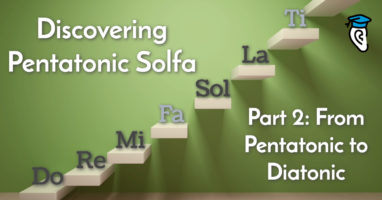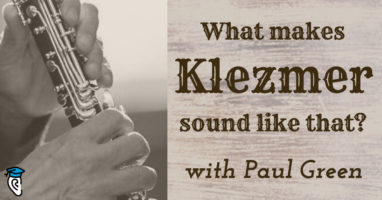Times they are a-changin’. As musicians, we live these immortal words of Bob Dylan. From the winding of a melody to the progression of chords, music can be described as an art of the movement of sounds in time. This week, we moved from five solfa notes to seven, learned about dynamic motion in the scales of klezmer music, and relished quotes on the ever-shifting world of improvisation.
But the biggest change for us is our own transition from two brands to one brand in our company. Yes, Easy Ear Training is heading over to become part of Musical U.
Sunset, Sunrise
 For you followers of Easy Ear Training, this transition will come as no surprise. Since launching Musical U, our new brand and product has grown and matured into a comprehensive source for musicality training – including ear training. With all our focus on one brand, we will be better able to serve you in your quest to become more musical.
For you followers of Easy Ear Training, this transition will come as no surprise. Since launching Musical U, our new brand and product has grown and matured into a comprehensive source for musicality training – including ear training. With all our focus on one brand, we will be better able to serve you in your quest to become more musical.
Read our founder Christopher Sutton’s words about how Easy Ear Training is becoming part of Musical U!
Two Steps to Solfa Skills
 Pentatonic (five-note scale) solfa is a great way to begin your exploration of this musical superpower. In Discovering Pentatonic Solfa, Part 1, worked out our ears on a number of pentatonic melodies. But once you’ve made it to five, it’s time to move on to the seven-note diatonic scale. Discovering Pentatonic Solfa, Part 2 expands our ears with nothing more than a “la” and a “ti”.
Pentatonic (five-note scale) solfa is a great way to begin your exploration of this musical superpower. In Discovering Pentatonic Solfa, Part 1, worked out our ears on a number of pentatonic melodies. But once you’ve made it to five, it’s time to move on to the seven-note diatonic scale. Discovering Pentatonic Solfa, Part 2 expands our ears with nothing more than a “la” and a “ti”.
For a great history lesson on Solfege, have a look at this blogpost from Let’s Play Music. Once you speak Solfa, your new music superpower will amaze and astound.
Are you looking for a song to teach your young choir about pentatonic solfa? Members of The Australian Girls Choir demonstrate “Pentatonic Patchwork”, a fun and educational warm-up song, composed by Mark Puddy:
You can download more free resources on Pentatonic Patchwork, including scores. Like Mark Puddy’s music? You can learn more about him at his MarkPuddy.com.
In this week’s article, we took you from pentatonic to diatonic Solfa. What is the major diatonic scale, anyway? Guitarist Steve Stine for Guitarzoom explains in this tutorial video.
“What we play is life.”
 While we may have an idea of what the structure of our day will hold, we create movement in life with our our moment-to-moment thoughts and decisions. That’s why Louis Armstrong likened improvisation to playing life. Let yourself move into a new awareness of spontaneous creation with 10 Inspiring Quotes about Musical Improvisation.
While we may have an idea of what the structure of our day will hold, we create movement in life with our our moment-to-moment thoughts and decisions. That’s why Louis Armstrong likened improvisation to playing life. Let yourself move into a new awareness of spontaneous creation with 10 Inspiring Quotes about Musical Improvisation.
Are you in the need of more music inspiration quotes? Musician Todd Green offers this extensive list of quotes about improvisation, the power of music and much more.
Jazz is the music genre we associate most often with improvisation. Learn Jazz Standards has 15 awesome jazz quotes to inspire music and creativity.
Ooh la la! Valentine’s Day just around the corner! Check out these love quotes from your favorite musicians compiled by Classical Musicians Everywhere to impress your honey bunny.
Klezmer Character
 The dynamic motion of klezmer music, whether a dance tune or a free-rhythm doina, is in part due to the energy embedded in the scales of the genre. Learn more about these scales – with mystical names like Ahava Rabboh (Great Love) and Misheberakh (The One Who Blesses) – from klezmer clarinetist Paul Green in What Makes Klezmer Sound Like That?
The dynamic motion of klezmer music, whether a dance tune or a free-rhythm doina, is in part due to the energy embedded in the scales of the genre. Learn more about these scales – with mystical names like Ahava Rabboh (Great Love) and Misheberakh (The One Who Blesses) – from klezmer clarinetist Paul Green in What Makes Klezmer Sound Like That?
Have you ever heard of the the “Misheberakh” mode in music? The Klezmer Fiddle discusses this mode and the main scales found in Klezmer music.
Do you want a great lesson on how to play Klezmer clarinet, just like Paul Green? Klezmer Clarinetist Oleg Lapidus offers this lesson on how to play “Khosn Kale Mazl Tov”.
Klezmer music is all about expressing yourself to the maximum! Klezmer clarinetist Corrado Giuffredi gives us an inside look into some of his favorite Klezmer techniques.
Next time we hear from Paul Green, we’ll learn how this ancient genre is changing and growing in the 21st century.
From genres, to improvisations, to our growing musicality skills, to our own evolving musicality education service – whether we know it or not life is constant motion. So check out these articles – catch the wave and ride with us to new experiences of musical motion.







